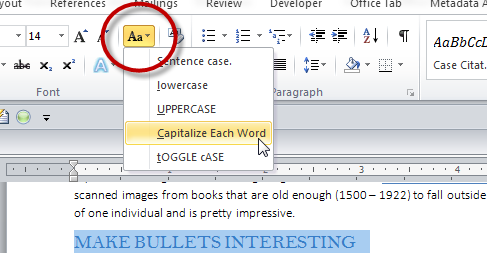Control (Microsoft) Word

Microsoft Word is a powerful word processing application, but it can also frustrate users because of formatting issues and re-keying information. Learning a few tips can save you lots of time. Following are a few secret – and simple – weapons to make dealing with a Word document easier.
Magic Eraser
 In Microsoft Word 2007 and up you can easily clear all formatting from a document. If you’ve copied and pasted from other documents or the web you know that formatting trails with the copied text and can wreak havoc on a new document. If you want to simply remove all document formatting to start anew select the text you want to remove formatting from and click on the icon in your Home tab in the Font group that looks like an eraser – et voila!
In Microsoft Word 2007 and up you can easily clear all formatting from a document. If you’ve copied and pasted from other documents or the web you know that formatting trails with the copied text and can wreak havoc on a new document. If you want to simply remove all document formatting to start anew select the text you want to remove formatting from and click on the icon in your Home tab in the Font group that looks like an eraser – et voila!
(F/K/A) Paste Special
When you are pasting text from another source, don’t simply paste the text into your document. Often it will change the formatting of your document and you have to spend time fixing it. You can avoid this problem simply by controlling how text is pasted into your document.
Once you have copied text (CTRL+C), instead of simply hitting paste on your toolbar or using the paste command (CTRL+V), right-click in your document where you want the text pasted. When you right-click, your context menu should have a section called Paste Options. In this section, there should be multiple clipboards. Each one pastes your text in a different way. To see what each looks like, hover your mouse pointer over each clipboard. When you see the result you want, then click that clipboard.
This trick will save you a significant amount of time that you would otherwise spend cursing at your computer. Of course, you can still go into the Paste menu in the Home tab, Clipboard group and choose Paste Special and peruse different text options – but you probably won’t have to.
Painting in Word
Sometimes you can’t just make formatting behave, especially when you are inserting text into an existing document, even as “plain text”. There is a tool in Word that allows you to take the formatting that appears in one piece of text and apply it to another piece of text. This can be very useful in many circumstances.
To use the format painter, select the text that has the formatting that you want. Once your text is selected, click the format painter button (Home tab, Clipboard group). Next, select the text that you want to apply the formatting to. You will see that your cursor has become a paintbrush. Once you have selected the text Word will automatically apply the formatting.
Change Capitalizations
 You can easily change the capitalization of any text with a click of a button: whether you would like to convert the text to all lower case, Sentence case, UPPERCASE, or if you left caps lock on – tOGGLE cASE.
You can easily change the capitalization of any text with a click of a button: whether you would like to convert the text to all lower case, Sentence case, UPPERCASE, or if you left caps lock on – tOGGLE cASE.
First, highlight the text you wish to affect. On a PC, go to the Home Tab, click on the “Aa” pull-down menu near the font/size menu. On a Mac, this option is available via Format > Change Case.
Autocorrect
Autocorrect in MS Word can help you add text automatically as you type. For instance, you can add an acronym, like FMLA and when you type it in autocorrect will insert “Family Medical Leave Act”.
To add text entries that are inserted automatically when you type a specific set of characters, you need to use the AutoCorrect dialog box.
- Click the File tab.
- Click Options.
- Click Proofing.
- Click AutoCorrect Options, and then click the AutoCorrect tab.
- Select the Replace text as you type check box, if it is not already selected.
- Under Replace, type the characters that you want to use for your automatic text.
Options for formatting and special characters in Autocorrect are limited. To get around that limitation merely highlight the phrase you want to use and then follow the instructions above. You can choose to use formatted text if you have a firm Style sheet or template. For instance, by highlighting “Social Security Act (“Act”), 42 U.S.C. §§ 401 et seq” in a document you can add an autocorrect shortcut that will insert that in a document when you type in /SSA. The autocorrect library is shared across Microsoft Office, so this will work in PowerPoint, Outlook, Excel and OneNote as well.
Quick Parts
The Quick Parts library acts as your document building blocks library. By saving selections of commonly used text, address blocks and other common information you can able to quickly craft documents based on your previous work.
To add selections to the gallery for use in all documents:
- Select the text you’d like to save
- Right click on the selected text
- Choose ‘Add to Quick Parts Gallery’
- or select Quick Parts from the Insert tab and choose “Save Selection to Quick part Gallery”
To insert a Quick Part into a document
- Place your cursor at the place in the document you’d like the part to be added
- Open the Quick Part s gallery from the Insert tab
- Select the Quick Part text you’d like to use
- Once you click on the text you’d like to add, you will see it appear in your document
You can also add the Quick Parts insert tool to your toolbar for easy access – just right click on Quick Parts and choose “Add to Quick Access Toolbar”. Be aware that if you move to a new computer or a new version of the software you will lose your QuickParts so make sure to back them up.
Fillable Forms/Templates
Did you know you turn an MS Word document into a fillable form? Just add form fields with the hidden Designer tab, save the document as a template and you and your team can fill out documents instead of finding the last copy of the document you created. If you have never done it before (and even if you have) you will need a tutorial.
Conclusion
A little know-how with Microsoft Word can go a long way to reduce your frustrations. Customizing your settings, learning shortcuts and taking a class for lawyers like this one from Barron Henley (NC tech CLE credit!) or the tutorials from Deborah at Legal Office Guru will help you master this application and spend more time focusing on your words, not Word!